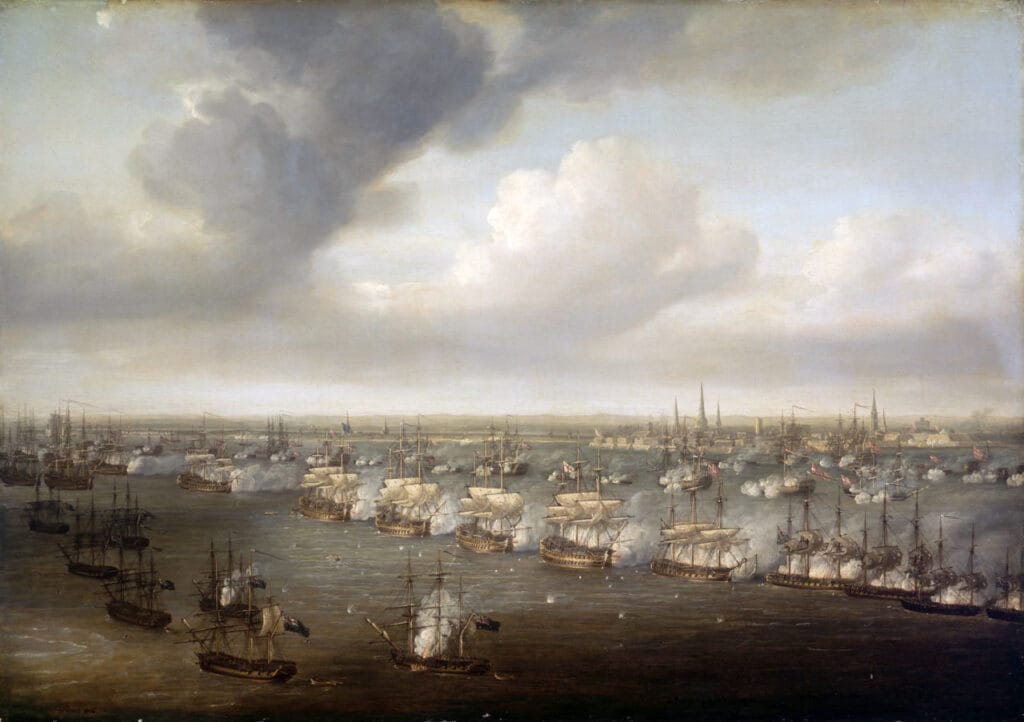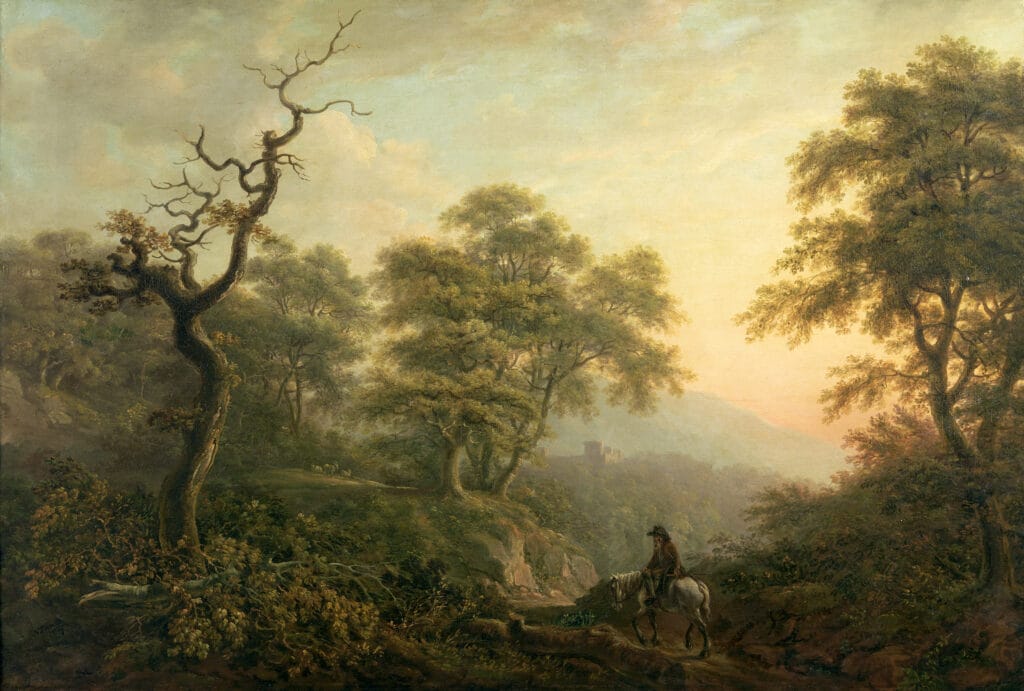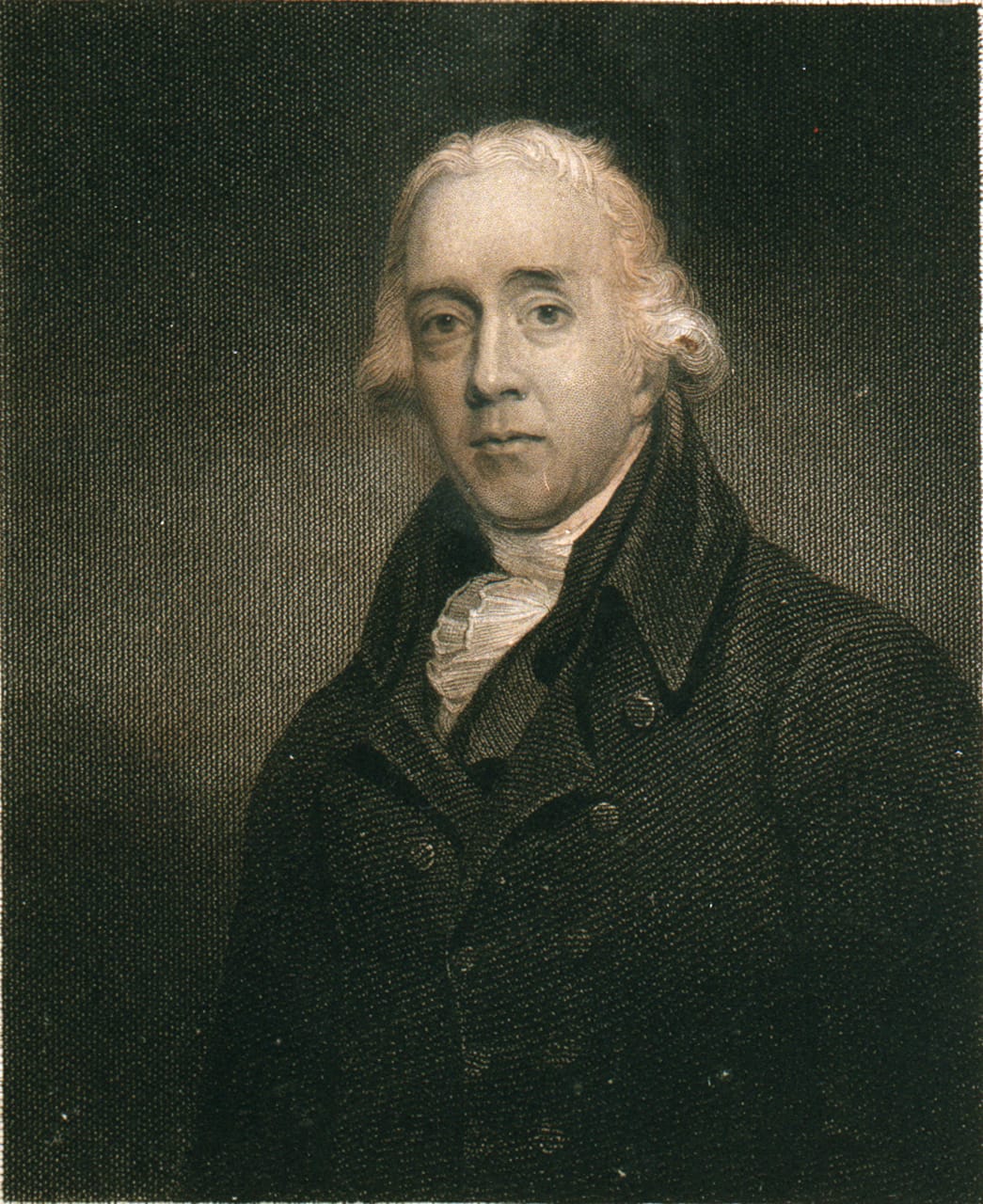Maritime art is a genre that has captivated the human imagination for centuries. It encompasses a vast array of subjects related to the sea, such as seascapes, naval battles, and coastal scenes, among others. One of the most renowned artists in this field is Nicholas Pocock, a British painter who made significant contributions to the world of maritime art during the late 18th and early 19th centuries.
Born in 1740 in Bristol, England, Pocock displayed a talent for drawing at a young age. He initially pursued a career in the maritime industry, working as a sailor and eventually becoming a ship’s master. However, his passion for art led him to leave the sea and dedicate his life to painting. Pocock’s extensive knowledge and experience of maritime life allowed him to create incredibly accurate and detailed depictions of seafaring vessels and events, making his work highly sought-after by collectors and enthusiasts alike.
In this deep dive, we will explore the life and career of Nicholas Pocock, examining the key elements of his maritime art and delving into some of his most influential works. We will also discuss the impact of Pocock’s art on maritime culture and modern interpretations of maritime art, as well as the influence of his work on contemporary artists. Finally, we will consider Pocock’s legacy in museums and galleries and the role of maritime art in modern culture.

The Life and Career of Nicholas Pocock
Nicholas Pocock’s life was shaped by his fascination with the sea and his passion for art. Growing up in a bustling port city like Bristol, he was constantly surrounded by seafaring activity, which undoubtedly influenced his artistic pursuits. As a young man, Pocock worked as a sailor on various merchant ships, eventually rising to the rank of ship’s master. This firsthand experience of life at sea provided him with the knowledge and inspiration for his future career as a maritime artist.
In the early 1770s, Pocock retired from seafaring and began to focus on his art. He started by creating illustrations for a book entitled “The Marine Practice of the Sextant,” which showcased his technical expertise in depicting maritime instruments. This project helped Pocock gain recognition in the art world, and he soon found success as a painter of ship portraits, naval battles, and coastal scenes. His attention to detail and ability to accurately convey the atmosphere of the sea earned him a loyal following among art collectors and naval enthusiasts.
Throughout his career, Pocock maintained close ties with the British Royal Navy, often receiving commissions to paint scenes of famous naval engagements. He also became an associate of the Royal Academy, where he exhibited his work regularly. Pocock’s artistic output was prolific, and his paintings remain highly valued by collectors and museums alike.
Key Elements of Pocock’s Maritime Art
Nicholas Pocock’s maritime art is characterized by its meticulous attention to detail, technical accuracy, and evocative rendering of the sea. These key elements combined to create a distinctive style that set Pocock apart from other artists of his time.
First and foremost, Pocock’s extensive experience as a sailor allowed him to accurately depict the various types of vessels, rigging, and equipment found on ships of the period. His familiarity with maritime life also informed his ability to capture the atmosphere of the sea, with its ever-changing weather conditions and dramatic lighting. This precise representation of the maritime environment lends an air of authenticity to Pocock’s work that is both impressive and captivating.
Another key element of Pocock’s maritime art is his masterful use of color and light. His seascapes often feature a striking contrast between the bright, sunlit sky and the dark, churning waters below. This interplay of light and shadow creates a sense of depth and movement in Pocock’s paintings, making the viewer feel as though they are witnessing the scene firsthand.
Finally, Pocock’s depictions of naval battles and maritime events showcase his ability to convey the drama and excitement of these moments in history. Through carefully composed scenes and dynamic action, Pocock captures the chaos, heroism, and sheer power of the sea and its vessels in his art.

Influential Works by Nicholas Pocock
Over the course of his career, Nicholas Pocock created numerous works that have left a lasting impact on the world of maritime art. Some of his most influential paintings include:
- “The Glorious First of June” (1795): This large-scale painting depicts the famous naval battle between the British Royal Navy and the French fleet during the French Revolutionary Wars. Pocock masterfully conveys the drama of the engagement, with ships locked in combat, cannon fire lighting up the sky, and the sea churning with the chaos of battle.
- “The Battle of Cape St. Vincent” (1797): Another of Pocock’s impressive battle scenes, this painting captures the British victory over the Spanish fleet during the French Revolutionary Wars. The composition showcases Pocock’s skill at depicting the intricate maneuvers of naval warfare, as well as his ability to create a sense of excitement and tension through his use of color and light.
- “The Capture of the ‘Amazone'” (1782): This painting portrays the capture of the French frigate “Amazone” by the British ship “Santa Margarita” during the American Revolutionary War. The scene is filled with action and energy, as the two ships engage in a fierce struggle amidst the rolling waves. Pocock’s attention to detail in the rigging and equipment of the vessels demonstrates his deep understanding of maritime life.
These and other works by Pocock have been celebrated for their technical accuracy, artistic skill, and ability to transport viewers to the heart of the maritime world.
The Impact of Pocock’s Art on Maritime Culture
Nicholas Pocock’s art has had a significant impact on maritime culture and the broader art world. His paintings serve as important historical records of naval events and provide insights into the daily lives of sailors and the workings of ships during the 18th and early 19th centuries.
Furthermore, Pocock’s work has served as an inspiration for future generations of maritime artists, who have built upon his techniques and style to create their own unique interpretations of the sea. His influence can be seen in the work of artists such as J.M.W. Turner and Thomas Somerscales, who continued to explore the themes and aesthetics of maritime art in their own distinctive ways.
Moreover, Pocock’s art has contributed to a greater appreciation and understanding of maritime history and culture among the general public. His vivid depictions of naval battles and seafaring life have sparked interest in the stories and events of the past, inspiring countless books, films, and exhibitions on the subject.
Modern Interpretations of Maritime Art
While the golden age of maritime art may have passed, the genre continues to evolve and inspire contemporary artists. Modern interpretations of maritime art can be seen in various forms, from realistic depictions of ships and seascapes to more abstract and conceptual works that explore themes of human connection, environmental concerns, and the passage of time.
Some contemporary artists who have been influenced by the maritime art tradition include Ran Ortner, who creates large-scale, hyper-realistic paintings of the ocean that capture the power and beauty of the sea, and Mary Iverson, whose work combines traditional maritime themes with elements of surrealism and geometric abstraction.
Digital art has also played a role in the continued evolution of maritime art, with artists such as Corey Arnold using photography and digital manipulation to create striking images of seafaring life and the natural world.
The Influence of Pocock’s Work on Contemporary Artists
The legacy of Nicholas Pocock continues to be felt in the work of contemporary artists, who draw inspiration from his attention to detail, mastery of color and light, and ability to evoke the atmosphere of the sea.
Artists such as Montague Dawson and Tim Thompson have been heavily influenced by Pocock’s style and subject matter, creating their own maritime paintings that reflect the traditions of the genre while adding their own unique touches. Pocock’s influence can also be seen in the work of artists who explore the more abstract and conceptual aspects of maritime art, such as the aforementioned Mary Iverson, whose work incorporates elements of both Pocock’s realism and modern artistic sensibilities.
In addition, Pocock’s work has inspired countless non-visual artists, such as writers and filmmakers, who have used his paintings as a starting point for their own creative projects centered around maritime themes.
Pocock’s Legacy in Museums and Galleries
Nicholas Pocock’s legacy can be seen in the many museums and galleries that feature his work. His paintings are highly valued by collectors and institutions, and can be found in some of the world’s most prestigious art collections.
The National Maritime Museum in Greenwich, London, houses a significant number of Pocock’s paintings, including several of his most famous naval battle scenes. The Bristol Museum and Art Gallery, located in Pocock’s hometown, also has a collection of his work on display, as do many other museums and galleries throughout the UK and beyond.
Pocock’s paintings continue to attract crowds and inspire awe among viewers, both for their technical precision and their ability to transport the viewer to another time and place.
The Role of Maritime Art in Modern Culture
Despite the changes in society and technology over the centuries, maritime art remains a vital part of modern culture. The sea and its vessels continue to hold a fascination for people around the world, and the rich history and culture of seafaring life continue to inspire artists and enthusiasts alike.
Maritime art can be seen as a reflection of human history and the relationship between humans and the natural world. It provides a window into the daily lives of sailors, the power and beauty of the sea, and the important role that maritime activity has played in shaping our world.
Moreover, maritime art serves as a reminder of the ongoing importance of preserving and protecting our oceans and the environment. Many contemporary artists use maritime themes to explore issues related to climate change, pollution, and the impact of human activity on the natural world.
Impact of Nicholas Pocock’s Art
Nicholas Pocock’s art has had a profound and enduring impact on the world of maritime art and culture. His technical precision, artistic skill, and ability to capture the atmosphere of the sea continue to inspire artists and captivate viewers around the world.
Pocock’s legacy can be seen in the many museums and galleries that feature his work, as well as in the ongoing evolution of maritime art as a genre. His paintings serve as important historical records of naval events and seafaring life, while also providing a source of inspiration for contemporary artists who continue to explore the themes and aesthetics of maritime art.
In the end, Nicholas Pocock’s art is a testament to the enduring power and beauty of the sea, and its ability to inspire creativity and imagination in artists and viewers alike.
